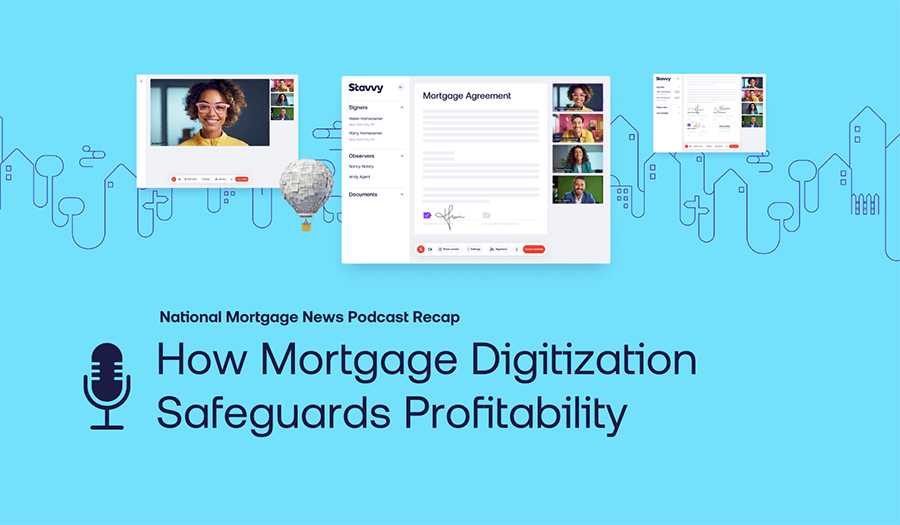On September 5, 2024, Stavvy hosted the webinar, “Advancing Your Digital Default Servicing Strategy”, with The Five Star Institute. The session was dedicated to the topic of digital transformation in default servicing operations and the critical role that automation plays in this evolution.
Stavvy’s Chief Strategy Officer, Angel Hernandez, was joined by a panel of subject matter experts including:
- Sherri Goodman - SVP, Contact Center Operations - Ocwen Financial Corporation/PHH Mortgage
- Paul Hooton - VP, Loss Mitigation and Foreclosure - Servbank
- Todd Mobraten - CEO - OrangeGrid
The webinar’s topics were designed to inform mortgage servicers on how to develop a digital-first strategy that minimizes default servicing costs while increasing pull-through rates.
Here are four lessons learned in the discussion.
Lesson 1: The time for digital transformation is now.
The mortgage servicing industry is constantly evolving, making it difficult to predict the best time to implement digital transformation initiatives. Most mortgage servicers don’t want to risk disruption when profits are strong and business is booming. On the other hand, when conditions aren’t as favorable, it can be difficult to allocate internal resources - both human and financial - to implement digital transformation initiatives.
However, recent developments underscore the value of prioritizing a digital-first approach to meet demand, stay compliant, and exceed customer expectations.
The mortgage industry is cyclical, and Hernandez shared his optimism that the cycle is in a stable spot amid falling interest rates. Despite the rate drops, other indices may signal forthcoming loss mitigation activity, including higher credit card debt and decreased household savings. These dynamics may indicate imminent consumer-facing activity to assist homeowners in need.
It’s been a busy time in the regulatory environment as well, with headline-making announcements including proposed changes to Regulation X. While these changes are not yet final, it does indicate where the agencies are heading given the increased emphasis on streamlined workflow activities, enhanced homeowner communication, and communication requirements in additional languages. This shift extends beyond the CFPB, as counterparties and investors are moving toward digitizing processes designed to increase efficiency in the capital markets as well.
It’s clear that the old way of doing things, which is paper-dependent and people-dependent, is not enough to meet the rapidly changing needs of mortgage servicers and homeowners. Investing in technology and leveraging automation can help all parties gain efficiency while saving time and money.
Lesson 2: COVID-19 accelerated meaningful and lasting changes to default servicing operations.
Although we are some time removed from the height of the pandemic, it’s impossible to ignore its lasting impact on business operations. It was a time of innovation for mortgage servicers, forever shifting homeowner interactions toward a digital-first approach.
Goodman recalled that the most important change made during the “forbearance stampede” of April 2020 was enabling borrowers to request assistance on PHH Mortgage’s website. The functionality was enacted quickly and featured an interactive form that asked homeowners the same questions they would have answered in a conversation with a call center representative.
The form captured their responses, leveraged a script to process the data, and quickly sent a letter about the most appropriate resolution option. While it wasn’t always 100% successful, the low 5-10% fallout rate took significant pressure off call center agents, who were experiencing their own personal stresses at the time.
PHH Mortgage’s proprietary scripting system is integrated with its mortgage servicing platform that pulls in the data. It provides agents with the right answers for the right situations based on the loan type, the state where the property resides, and the loan circumstances. During the pandemic, PHH Mortgage received changes almost daily from GSEs, individual states, and regulators. Keeping hundreds of call center agents informed of these changes was a significant operational challenge. By coding this data directly into the platform, agents could access the most current and up-to-date information at all times.
Hooton echoed Goodman’s comments and offered that Servbank undertook many of the same initiatives during the pandemic. The top priority was expanding homeowner communication beyond phone calls to include online portals, emails, text messages, mobile apps, and self-service options in the IVR. Leveraging technology to expand communication channels allowed call center agents to work remotely while providing the same level of service. It also offered the ability to provide resolution at the point of sale, delivering a far superior homeowner experience versus having to follow up at a later time.
Lesson 3: Digital interactions can provide more comfortable experiences for distressed homeowners.
A sentiment shared by all panelists is that digital options can help homeowners avoid embarrassing interactions with mortgage servicers. Homeowners experiencing hardship are often uncomfortable sharing the challenges they face with an unknown call center agent. Technology can help overcome this hurdle while still delivering a personal touch.
Goodman shared that PHH Mortgage is advancing its self-serve approach by integrating Live Chat on its website. When homeowners visit to request assistance, they will be able to chat with an agent in real time. Options like Live Chat and SMS text messaging can provide an in-between solution that delivers a human touch without the human embarrassment that might accompany a homeowner disclosing their circumstances.
Lesson 4: ROI is the main goal of mortgage technology adoption.
Coming from a provider’s perspective, Mobraten shared that the top priority of investing in technology is getting to ROI as quickly as possible. He added that any challenge a mortgage servicer is looking to solve won’t be their last. That’s why it’s imperative to evaluate tech providers on their ability to solve more than just one problem because there will inevitably be an opportunity for the solution to expand its reach and solve future challenges.
Goodman echoed the need for mortgage servicers to have a high confidence level that they’ll realize the return and savings they expected from the technology. Promises made in the sales process must come to fruition and mortgage servicers need assurances of value creation before making significant investments. Goodman recommended free trials and value-based pricing to verify the value being delivered in advance of a technology purchase.
Regarding ROI, Hooton suggested that servicers start by calculating the ROI vs the upfront cost to determine how long it will take to break even. He also encouraged mortgage servicers to consider potential competing priorities in their organizations. That way, if a conflict arises, they will have already answered the question, “What will bring ROI most quickly?”
Hernandez concluded by saying that the right technology partner will provide mortgage servicers with meaningful insight into ROI. That partner can also act as a design partner to understand the total impact that the technology can make across all business operations. This ability to offer a top-down, holistic, and inclusive view is the sure sign of a quality mortgage technology partner.
Click here to watch the full webinar recording, including interactive audience poll questions and responses. Contact Stavvy to learn more about our loss mitigation solution for mortgage servicers.



![[Webinar Recap] Advancing Your Digital Default Servicing Strategy](https://blog.stavvy.com/hubfs/advancing-your-digital-default-servicing-strategy-blog-recap.png)